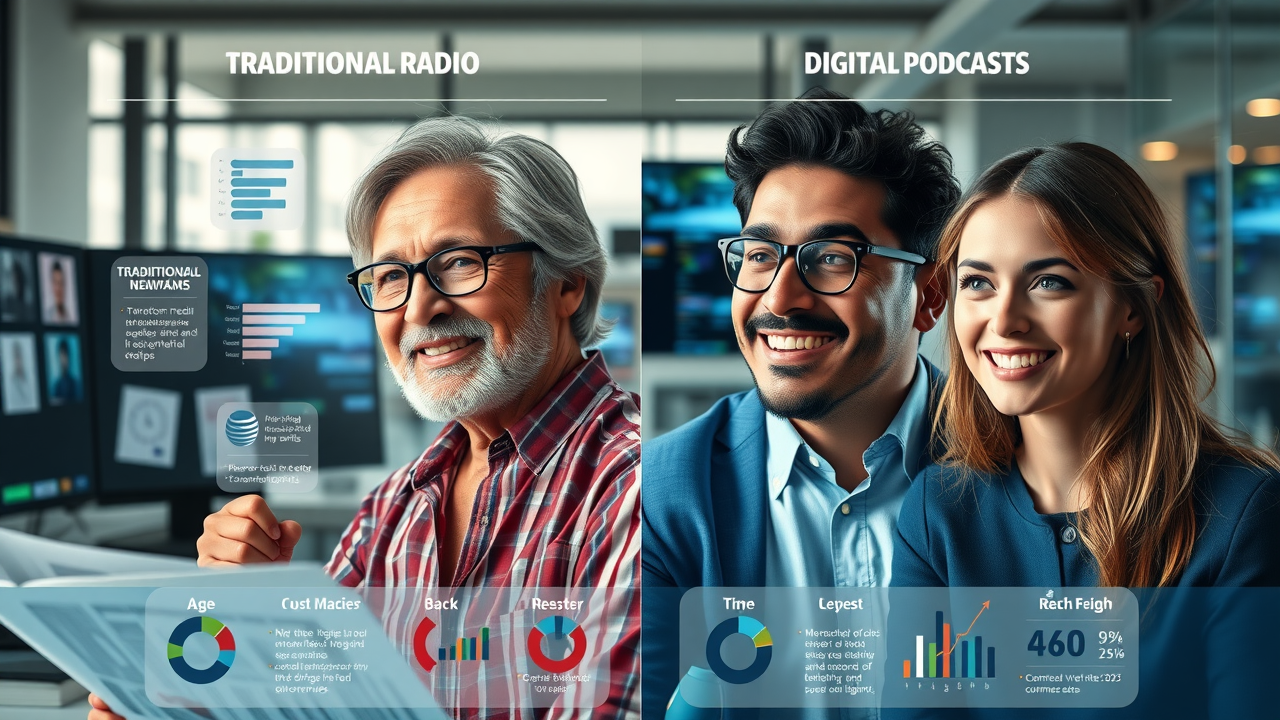Did you know that over 70% of global digital ad spend is now allocated across just a handful of media channels? This surprising fact highlights a critical truth: in today’s fast-changing digital environment, understanding the importance of media channels isn’t just for media professionals—it’s essential for every business, marketer, and communicator. In this comprehensive guide, we’ll reveal the powerful influence, strategy, and future trends shaping how media channels drive reach, engagement, and brand success. Whether you’re building your first media plan or looking to overhaul your existing media mix, this article offers actionable insights you can use to stay ahead.
Unveiling the Importance of Media Channels: The Surprising Truth Behind Their Influence
- Did you know that over 70% of global digital ad spend is now allocated across just a handful of media channels? Discover why understanding the importance of media channels is essential for any modern communication strategy.

Essential Insights: What You’ll Discover About the Importance of Media Channels
- Gain an understanding of how media channels shape perceptions
- Learn to differentiate between traditional and digital media channels
- Understand how to develop a balanced media mix for effective media marketing
Defining the Importance of Media Channels in Contemporary Communication
Media Channels Explained: Types and Unique Attributes
The term media channels refers to the various pathways organizations and individuals use to disseminate information, advertise, and connect with their target audience . These channels can generally be grouped into traditional media (like TV, radio, and print), digital media channels (including websites, email marketing, and online ads), social media platforms , and increasingly common hybrid models. Traditional media channels provide broad reach and credibility, making them ideal for establishing brand awareness among diverse demographics. Meanwhile, digital media and social media platforms offer real-time engagement, precise targeting, and measurable results that are critical for today’s agile marketing strategies.
Each media channel comes with unique attributes that influence how content is perceived and acted upon. For example, print media offers a tactile experience and longevity, TV reaches large audiences with impactful visuals, and digital channels enable tailored content and interactivity. The rise of social media marketing means that conversations around brands and products can go viral, helping to build brand loyalty among consumers in ways that traditional platforms can’t match. Understanding the subtle nuances and strengths of each type is foundational to maximizing your media mix and boosting media marketing outcomes.

How Media Channels Amplify Social Media Marketing and Media Marketing
The rapid evolution of media channels has supercharged the potential for social media marketing and broader media marketing campaigns. Today, brands use a combination of traditional, digital, and social media to engage their target audience at every stage of the customer journey —from initial brand awareness to conversion and advocacy. A well-chosen media channel can amplify your marketing message, extend your reach, and foster meaningful engagement by leveraging the strengths of each platform.
For example, integrating TV and radio ads with a dynamic social platform presence allows brands to connect with both older and younger audiences, expanding their market share. By aligning the right messaging with the preferred media platform of a specific demographic , companies can keep their marketing campaigns relevant, timely, and more likely to inspire action. This synergy is the backbone of modern marketing strategy .
Media Channel Strategies: Building Your Media Plan for Maximum Impact
Crafting a Media Mix: The Role of Various Media Channels
- Integrating social media, traditional media, and digital media in a cohesive marketing strategy
To maximize the importance of media channels , you need a thoughtfully crafted media mix . A media mix is a combination of different communication channels —like print, TV, radio, email marketing, websites, and social media platforms —that work together to achieve your marketing goals. The most effective media marketing strategies embrace both new and traditional tools, leveraging the unique benefits of each to reinforce messaging and broaden your target audience reach.
Integrating multiple media channels means you’re not overly reliant on a single outlet. For example, TV ads and print media create authority, while digital channels and social media provide instant feedback, analytics, and the opportunity to engage with consumers in real time. Aligning your strategy with your audience’s media consumption habits ensures that your media plan is both balanced and adaptive, leveling up your overall marketing campaigns .

Media Platform Selection: Matching Message to Channel
Choosing the right media platform is essential for ensuring your message resonates with the right people. Not all media channels will be effective for every message or target audience . For example, if your campaign is visually driven and aimed at a millennial demographic, platforms like Instagram or TikTok are ideal. For more formal or business-focused messaging, email marketing or LinkedIn may provide better results.
An effective media plan requires a clear understanding of where your audience spends their time and what types of content they engage with. Testing, data analysis, and audience feedback all help in refining which media channels and media platforms are most effective for your specific marketing strategy . This strategic alignment boosts both engagement and return on investment (ROI).
Comparing Traditional and Digital Media Channels: Which Boosts Media Marketing Most?
Traditional Media Channels: TV, Radio, and Print

Traditional media channels —including television, radio, and print—have been the backbone of media marketing for decades. Their broad reach can swiftly build brand awareness and trust, particularly among audiences that value authority and consistency. TV and radio advertising provide multisensory impact, while print offers high credibility and a sense of permanence. Despite the rise of digital options, traditional media remains highly effective for certain segments, such as older generations or audiences in regions with less internet penetration.
However, traditional channels can be less targeted and often more expensive than their digital counterparts. The lack of immediate feedback and the challenge of measuring specific engagement or ROI are among the key obstacles facing marketers who rely exclusively on traditional media campaigns . Blending traditional and digital approaches is increasingly becoming the standard for comprehensive marketing strategy .
Digital Media Channels: Social Media, Email Marketing, and More
- Key benefits and challenges of digital and traditional media
Digital media channels have revolutionized how brands connect with consumers. Whether it’s through social media marketing , search engine ads, websites, or email marketing , these platforms offer unparalleled targeting and tracking. Social media platforms such as Facebook, Instagram, Twitter, and LinkedIn allow businesses to target specific demographics, measure engagement instantly, and even personalize content to individual users’ interests.
While digital tools provide flexibility and high ROI, they also introduce challenges like content oversaturation and fast-changing algorithms. Balancing digital and traditional channels in your media mix helps ensure you reach a wider range of potential customers with both authority and precision.
Harnessing Social Media and Social Media Platforms in Your Media Channel Mix
The Power of Social Media for Brand Engagement
Social media has emerged as a game-changer in media marketing . By enabling two-way communication, sharing, and user-generated content, platforms like Facebook, Instagram, TikTok, and Twitter foster deeper connections with audiences and fuel brand loyalty . Social media not only amplifies your brand’s voice but also offers invaluable data on what motivates and resonates with your target audience .
Effective use of social media platforms can rapidly increase your reach and make your brand a household name. Viral campaigns, hashtags, influencer marketing, and user interactions are just some ways brands can create buzz and value. For this reason, social is at the heart of every modern media plan .
Effective Social Media Platform Tactics for Media Campaigns
Building successful social media marketing campaigns requires a blend of creativity, analytics, and agility. Key tactics include aligning your brand message with platform culture—for example, short, catchy videos for TikTok or inspirational images for Instagram. Segmenting your content for each social media platform ensures maximum relevance and engagement.
Real-time interaction is also crucial. Responding to comments, hosting live events, and running time-sensitive campaigns can keep your followers engaged and loyal. Leverage the data-rich environment of digital media channels to continuously refine your approach and sustain momentum on each platform.
Optimizing Your Media Plan: Data-Driven Approaches to Media Marketing
Data Analytics: Measuring Media Channel Performance
- Tools and KPIs for social media marketing and media marketing success
In the era of big data, every aspect of your media channel performance can be measured. Key performance indicators (KPIs) like reach, engagement, conversion rate, and ROI are essential for evaluating success across media campaigns . Tools such as Google Analytics, Facebook Insights, and CRM software help marketers gather actionable insights and optimize their media plan for better results.
Data-driven media marketing empowers organizations to quickly pivot strategies, invest more in top-performing channels, and cut back on those with limited impact. This ongoing optimization is vital in maintaining a competitive edge and reaching your target audience cost-effectively.

Adapting Media Mix to Audience Behavior
Modern consumers have more choices than ever regarding where and how they consume information. Adapting your media mix to shifting behaviors means monitoring the platforms and formats your audience prefers. For instance, a younger audience may be more engaged with video content on mobile devices, while older demographics might gravitate towards email newsletters or print.
Flexibility and testing are key to success. Use A/B testing, audience surveys, and web analytics to understand trends, then adjust your media plan accordingly. This nimble approach keeps your brand relevant and ensures that your marketing dollars are invested wisely.
| Media Channel | Reach | Engagement | Cost | ROI |
|---|---|---|---|---|
| TV | Very High | Moderate | High | Variable |
| Radio | High | Moderate | Moderate | Moderate |
| Medium | Low | High | Low/Moderate | |
| Social Media | Very High | Very High | Low to Moderate | High |
| Email Marketing | High | High | Low | High |
| Digital Ads | High | High | Variable | High |
Integrating Media Channels: Creating a Cohesive Media Campaign
How a Balanced Media Channel Strategy Enhances Communication
Uniting various media channels into a seamless strategy amplifies the impact of your media campaign . A balanced approach leverages the strengths of each outlet—reaching a wider audience and reinforcing key messages through repetition and cross-channel engagement. For instance, a campaign might start with a high-profile TV ad, which is then boosted by targeted social media posts, followed by email reminders and in-depth website content.
This layered, multi-channel strategy increases the likelihood that your message will reach and resonate with different segments of your target audience . Consistent messaging across channels builds trust, while varied formats keep the audience interested and engaged. Over time, this approach fosters deeper connections and drives better marketing outcomes.

Case Study: Successful Multi-Channel Media Campaigns
Consider a national beverage brand that launched a new product using a multi-channel approach: TV commercials built excitement, print ads provided local relevance, and social media influencers engaged a younger crowd with shareable content. The campaign also included interactive YouTube videos and targeted email marketing to build anticipation.
By measuring results at each stage—views, engagement, redemption of promotional codes, and sales data—the brand could optimize future campaigns, ultimately achieving a higher ROI and stronger brand awareness than single-channel efforts.
Challenges and Opportunities in Today’s Media Channels
Media Channel Fragmentation and Consumer Choice
- Navigating an expanding universe of digital media and social media platforms
One of the biggest challenges marketers face is media channel fragmentation. As new digital media channels and social media platforms emerge, consumers can curate their own information diets, choosing what, when, and how they engage with brands. This makes it harder to capture attention and ensure consistent messaging. However, it also opens opportunities to reach potential customers through highly personalized and creative means.
Navigating this complex environment requires a willingness to test new communication channels , observe audience preferences, and adapt your media mix accordingly. Success comes from balancing reach and relevance—finding the right blend of platforms to achieve your unique marketing goals.
Addressing Trust and Credibility Across Media Channels

In today’s landscape, trust and credibility are major concerns for any marketing effort. With misinformation spreading easily online, audiences are more skeptical of both digital and traditional messaging. To overcome skepticism, brands must be consistent, transparent, and authentic in every media channel they use, backing their claims with facts and real results.
Earning trust starts with aligning your content across all media platforms , employing real customer testimonials, and providing clear value. By addressing credibility head-on, you can turn awareness into long-term brand loyalty and foster more meaningful connections.
Expert Perspectives: The Evolving Importance of Media Channels
"Media channels are not just conduits for content—they're active participants in shaping public perception." – Industry Media Strategist
Emerging Trends in Social Media Marketing and Media Marketing
The importance of media channels will only grow as technology evolves. AI-driven personalization, live streaming, interactive video, and AR/VR experiences are transforming how brands engage audiences. In the near future, expect further integration between traditional and digital media channels , more sophisticated audience segmentation, and greater emphasis on authentic, two-way interactions through social media platforms .
Proactive brands are already embracing these innovations—testing new formats, analyzing real-time behavior data, and building flexible media plans that adapt quickly. Keeping up with trends and continuously innovating will remain key to leveraging the full potential of every media channel .
Lists: Actionable Steps to Master the Importance of Media Channels
- Identify your audience and preferred media channels
- Develop a purpose-driven media mix
- Use analytics to refine your marketing plan
- Stay current with digital media channel innovations

People Also Ask: Understanding the Nuances of Media Channels
What is the role of media channels?
- Media channels serve as critical pathways to distribute information and connect with target audiences through various methods, including traditional and digital platforms.
What is the importance of channels in communication?
- Channels determine how efficiently messages are transmitted and understood, impacting communication clarity and effectiveness.
What is the importance of media in our society?
- Media channels inform, educate, entertain, and shape public opinion, thus playing a pivotal role in society’s progression.
Why are channels important?
- The choice of channels affects reach, engagement, and overall communication outcomes, making it essential to select the right media mix.
Frequently Asked Questions on the Importance of Media Channels
-
How do I choose the most effective media channel for my message?
To choose the most effective media channel, consider your target audience, campaign objectives, and the strengths of each platform. Analyze past performance data and align your message format with the platform where your audience is most active and engaged. -
Can traditional media channels still compete with digital platforms?
Yes, traditional media channels can still be effective, especially for building credibility, reaching broader audiences, or supplementing digital campaigns. A balanced media mix, tailored to audience preferences, often delivers the best results. -
How does media channel fragmentation impact marketing strategy?
Channel fragmentation increases both challenges and opportunities. Marketers need to diversify strategies, personalize messaging, and monitor more platforms to remain competitive, but this also allows better targeting of specific demographics. -
What trends are shaping the future of media marketing?
Key trends include artificial intelligence, influencer marketing, interactive and immersive content, cross-channel analytics, and continuous adaptation to changing consumer behaviors. Staying informed and flexible is critical for ongoing success.
Key Takeaways: Why Prioritizing the Importance of Media Channels is a Game-Changer
- Media channels directly influence reach and engagement
- An effective media plan employs a balanced media mix
- Continuous adaptation to media trends enhances success
Ready to Unleash the Power of Media Channels? Start Shaping Your Media Mix Today
- Take insights from this article to reevaluate your media strategy and maximize the impact of every channel in your next media campaign.
Ready to get started? Analyze your current media plan, embrace a balanced media mix, and watch your media marketing results soar!
Understanding the importance of media channels is crucial for effective communication and marketing strategies. The article “The Importance Of Marketing Channels (Plus 8 Functions Of A Successful Marketing Channel)” provides a comprehensive overview of how various channels facilitate market information collection, product distribution, promotion, transaction management, inventory handling, risk sharing, negotiation, and logistics management. Additionally, the “Influence of mass media” article explores how mass media shapes public opinion and behavior, highlighting its role in modern culture and communication. These resources offer valuable insights into selecting and utilizing media channels to enhance reach, engagement, and brand success.
 Add Row
Add Row  Add
Add 




Write A Comment